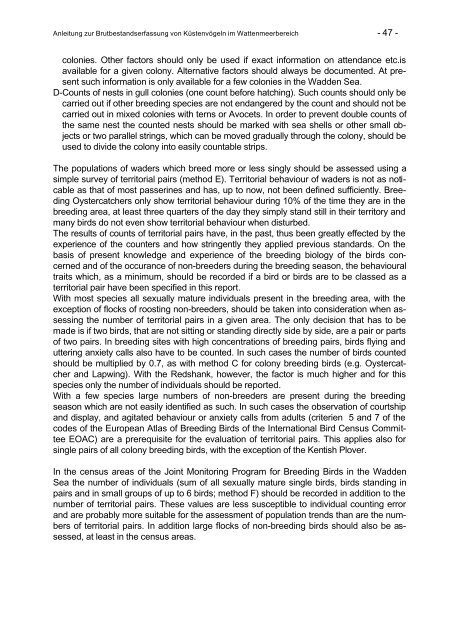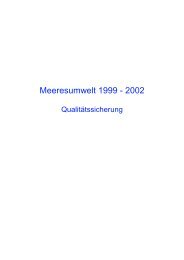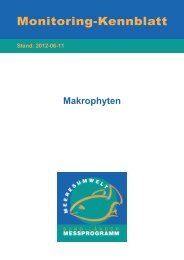Anleitung zur Brutbestandserfassung von ... - BLMP Online
Anleitung zur Brutbestandserfassung von ... - BLMP Online
Anleitung zur Brutbestandserfassung von ... - BLMP Online
Sie wollen auch ein ePaper? Erhöhen Sie die Reichweite Ihrer Titel.
YUMPU macht aus Druck-PDFs automatisch weboptimierte ePaper, die Google liebt.
<strong>Anleitung</strong> <strong>zur</strong> <strong>Brutbestandserfassung</strong> <strong>von</strong> Küstenvögeln im Wattenmeerbereich - 47 -<br />
colonies. Other factors should only be used if exact information on attendance etc.is<br />
available for a given colony. Alternative factors should always be documented. At present<br />
such information is only available for a few colonies in the Wadden Sea.<br />
D-Counts of nests in gull colonies (one count before hatching). Such counts should only be<br />
carried out if other breeding species are not endangered by the count and should not be<br />
carried out in mixed colonies with terns or Avocets. In order to prevent double counts of<br />
the same nest the counted nests should be marked with sea shells or other small objects<br />
or two parallel strings, which can be moved gradually through the colony, should be<br />
used to divide the colony into easily countable strips.<br />
The populations of waders which breed more or less singly should be assessed using a<br />
simple survey of territorial pairs (method E). Territorial behaviour of waders is not as noticable<br />
as that of most passerines and has, up to now, not been defined sufficiently. Breeding<br />
Oystercatchers only show territorial behaviour during 10% of the time they are in the<br />
breeding area, at least three quarters of the day they simply stand still in their territory and<br />
many birds do not even show territorial behaviour when disturbed.<br />
The results of counts of territorial pairs have, in the past, thus been greatly effected by the<br />
experience of the counters and how stringently they applied previous standards. On the<br />
basis of present knowledge and experience of the breeding biology of the birds concerned<br />
and of the occurance of non-breeders during the breeding season, the behavioural<br />
traits which, as a minimum, should be recorded if a bird or birds are to be classed as a<br />
territorial pair have been specified in this report.<br />
With most species all sexually mature individuals present in the breeding area, with the<br />
exception of flocks of roosting non-breeders, should be taken into consideration when assessing<br />
the number of territorial pairs in a given area. The only decision that has to be<br />
made is if two birds, that are not sitting or standing directly side by side, are a pair or parts<br />
of two pairs. In breeding sites with high concentrations of breeding pairs, birds flying and<br />
uttering anxiety calls also have to be counted. In such cases the number of birds counted<br />
should be multiplied by 0.7, as with method C for colony breeding birds (e.g. Oystercatcher<br />
and Lapwing). With the Redshank, however, the factor is much higher and for this<br />
species only the number of individuals should be reported.<br />
With a few species large numbers of non-breeders are present during the breeding<br />
season which are not easily identified as such. In such cases the observation of courtship<br />
and display, and agitated behaviour or anxiety calls from adults (criterien 5 and 7 of the<br />
codes of the European Atlas of Breeding Birds of the International Bird Census Committee<br />
EOAC) are a prerequisite for the evaluation of territorial pairs. This applies also for<br />
single pairs of all colony breeding birds, with the exception of the Kentish Plover.<br />
In the census areas of the Joint Monitoring Program for Breeding Birds in the Wadden<br />
Sea the number of individuals (sum of all sexually mature single birds, birds standing in<br />
pairs and in small groups of up to 6 birds; method F) should be recorded in addition to the<br />
number of territorial pairs. These values are less susceptible to individual counting error<br />
and are probably more suitable for the assessment of population trends than are the numbers<br />
of territorial pairs. In addition large flocks of non-breeding birds should also be assessed,<br />
at least in the census areas.










